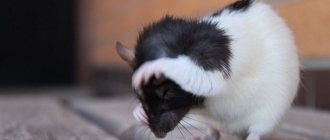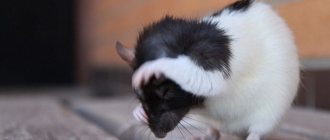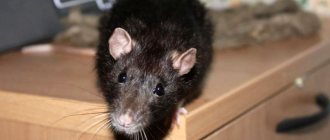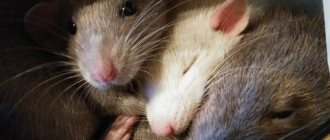- Wild animals
- >>
- Mammals
The Gambian rat is one of the largest species in the rodent family, but also one of the friendliest. Due to the large size of Gambian rats, they pose a serious threat to native species (especially nesting species) and crops, especially if they invade mainland Florida.
Structure and appearance
Gambian rats belong to the family of nezomyids from the order of rodents. This is a large animal the size of an average dog. The length of the body reaches 45 cm, and together with the tail - 91 cm. The average weight of the mammal is 1.5 kg, and for the largest individuals - 2.8 kg.
The Gambian rat has other names - hamster rat or marsupial rat - because it has cheek pouches. Their capacity is about 100 ml. A rodent can carry a huge amount of food into them.
Externally, African rats are similar to their European counterparts. They have a pointed muzzle, small eyes, and gray-brown hard fur. The long tail is covered with scales and very sparse coarse hairs. Interestingly, two-thirds of its length is dark in color, and the rest, towards the end, is light. The fur on the belly is slightly lighter than on other parts of the body.
The rather large ears are oval shaped and stand erect. The Gambian rat's eyes are surrounded by a dark edging - this is its main difference from other relatives. The nose and paws are pink, and the whiskers are dark.
Sexual dimorphism is weakly expressed - males are quite a bit larger than females. In individuals that live in captivity, there may be a slight pattern on the coat - stripes or spots in the hips and shoulder girdle, as well as on the head. Some domestic Gambian rats have unnaturally dark fur, closer to black.
Interaction with people
In many African giant countries, marsupials are valued as an important product.
They are easily tamed as pets. However, they were linked to the monkeypox outbreak in the US in 2003 and have since been banned from import to the US.
Ability to detect mines and tuberculosis aroma
These rats also become useful in some areas for detecting mines, as their keen sense of smell is very effective in detecting explosives, and they are light enough not to blow up any of the mines. The rats are trained by APOPO, a non-profit social enterprise based in Tanzania.
The method of training rats to detect mines was conceived and developed by Bart Witjens from Belgium. Training runs at four weeks of age, when the rats are processed to acclimate them to people and are exposed to a variety of sights and sounds. They learn to associate the clicker with the food reward of banana paste or banana peanuts. They are then trained to point to a hole with TNT in it by sniffing it out for five seconds. Then they learn to find the correct hole in the line of holes. Finally, the rat is trained to wear a harness and practice outdoors on the lead by finding inactivated shafts under the soil. At the end of their training they are tested: they must find all the mines in an area of 400 square meters that has been selected with the mines inactivated. This is a blind survey: their miners don't know where the mines are. If they succeed, they are certified as bomb-sniffing rats.
Duration and lifestyle
In the wild, African rats live for approximately 3 years. In their natural environment they have no enemies who would prey on this particular species. At home, representatives of this species can live longer - 5-7 years.
The animal is active mainly at night and sleeps during the day. When dusk falls, the Gambian rat goes in search of food. She stuffs the cheek pouches and brings them home. Rodents do not tolerate encroachment on their territory and jealously defend their nests.
Gambian rats are friendly towards humans and never attack them. Aggression is only possible if the animal has to defend itself.
Due to severe stress or fear, a rat may bite its offender.
Is it worth getting Dumbo the rat as a pet? Advantages and disadvantages
A pet rat can be a full-fledged four-legged friend. To understand whether such an animal is right for you, you should weigh all the advantages and disadvantages.
Pros:
- can be kept even in small housing;
- have a friendly disposition;
- clean;
- don't make noise;
- maintenance does not require large financial costs;
- easy care.
Minuses:
- without regular tactile contact with humans, rats may never be tamed;
- not suitable for people who spend most of their time at work, as animals need communication;
- cats and dogs can attack a rodent due to their hunting instinct.
Habitat
The Gambian rat lives mainly in the central parts of Africa. Rodents inhabit the territory from the southern borders of the Sahara Desert to the province of KwaZulu-Natal in the Republic of South Africa. They live in small groups of about 20 individuals in savannas and temperate zones.
Gambian rats prefer to live in wooded areas, as they usually use hollows in trees as homes. In the absence of such, rodents dig their holes directly in the ground. They can also live in mountainous areas. In this case, rock crevices serve as their home.
African rats are often found in close proximity to human settlements. They settle in cellars and basements of houses. Local residents do not like being around rodents because they quickly destroy food supplies and damage property.
Animal character
Breeders identify three temperaments characteristic of Dumbo:
- Learning ability. With regular training, the rodent quickly becomes tamed and learns to perform simple tricks.
- Laziness. This point follows from the first - the rat quickly understands the cause-and-effect relationship “following the command - a treat” and becomes lazy if it sees that there will be no reward.
- Friendliness. Dumbo loves to spend time with his owner. They take the initiative to get to know other household members. However, if the owner spends a lot of time outside the home, the pet may get bored. Therefore, veterinarians advise having two same-sex individuals at once.
Interesting Facts
Gambian rats are amazing animals. This is confirmed by the following facts:
- This species is considered one of the largest among rodents.
- Thanks to the large capacity of the cheek pouches, the rodent is able to carry about 3 kg of food in 1 hour.
- Gambian rats have poor vision but have an excellent sense of smell. They know how to search for unexploded mines, so they are often used as sappers.
- Gambian rodents can detect tuberculosis bacteria in saliva samples with 99% accuracy. If a laboratory technician takes an average of 3-4 days to study one analysis, then a rat can process about 100 tubes in 20-30 minutes. When she finds the tuberculosis bacilli, she freezes for a few seconds.
APOPO - it sounds proud
The Belgian Bart Witjens didn't care. He was so impressed by the statistics of deaths and injuries from mines that in 1998 he founded the Belgian non-profit organization APOPO (translated into Russian as the development of means for detecting anti-personnel mines).
As a child, Bart kept rats and other rodents, and while studying at university he learned about their ability to detect mines and explosives by smell. In addition, unlike a dog, a rat will not be able to accidentally activate the ammunition: the rodent is too light.
Bart Witjens with one of the sappers (photo source)
So what do we have? If you train rats, you can end up with an inexpensive, well-trained and massive army of tailed sappers capable of detecting anti-personnel and anti-tank mines. And without expensive equipment.
African (Gambian) marsupial rats (Cricetomys gambianus) were chosen for the role of sappers from the entire variety of rodents. Why them? Africa is their home. They are well oriented and accustomed to hot climates. Hardy and disease resistant. Compared to other relatives, they live quite long. But most importantly, they have an excellent sense of smell.
Natural enemies
In the wild, Gambian rats are sometimes attacked by large birds or predators. However, this is not so easy to do - rodents usually gather in groups, and together they are able to fend for themselves.
The greatest danger to rodents is humans. After all, their meat has a pleasant taste, and various dishes are prepared from it. Rats living near villages and cities are exterminated en masse because they cause enormous damage:
- destroy the soil structure;
- eat crops, grain and vegetable reserves;
- clog the sewer.
Electric models
Beginners should pay attention to more innovative gadgets. They are definitely a little more expensive
But in this case, the price increase proportionally affects safety.
We are talking about a family of rechargeable machines equipped with a rotating head. They do not cut, but grind down the cornea. With this approach, it is almost impossible to harm a dog or cat by catching too much of a nail. The high rotation speed of the tip ensures fast operation, and the low noise level does not bother four-legged patients at all. Any beginner can easily cope with such a mechanism.
Price – 481 – 1,859 rubles.
Some models are equipped with 2-3 heads, suitable for dogs or cats of various breeds and age groups.
After all, the claws of a dwarf poodle are much more delicate than those of a German shepherd. The same applies to young kittens and adult cats - their paws need to be treated with different elements. So, when purchasing a tool for trimming claws, you should consider this nuance.
Cost – 567 – 1,189 rubles.
The final touch is the rotation speed of the device head.
It directly affects the quality of claw grinding. After all, it is necessary not only to cut off the ends, but also to polish the ends so that the sharp edges do not injure the delicate pads of the paws. This operation is best done in a more gentle mode at low speeds. So a machine with gear shifting will come in very handy in this case.
Price – 497 – 1,566 rubles.
I like it I don't like it
Reproduction and offspring
Sexual maturity in these rodents occurs at six months of age. In nature, the mating season for Gambian rats occurs during the warm season. The male courts the female, after which mating occurs. Pregnancy lasts about a month, childbirth is easy.
One litter can contain from one to five rat pups. Newborns have no fur on their bodies and their eyes are closed. They open 20 days after birth. The ears of babies up to two weeks of age are folded, so they cannot hear anything.
Determining the sex of a rodent is quite simple. Already at the age of 9–10 days, nipples can be seen on the abdomen of female rats. Males do not have them.
The mother feeds the offspring with milk for 4 weeks. During this time, the cubs gradually grow hair and learn to eat.
- Males do not participate in raising the young, and sometimes even eat them.
- Females have a well-developed maternal instinct. They can take care not only of their own litter, but also of the offspring of other rats.
Caring for Albinos
White rats with red eyes have distinctive grooming needs due to the color of their body and eyes. White fur needs to be carefully combed, and in some cases the rat needs to be bathed
It is very important that there is no yellowness on the fur coat, because this is an obvious sign of poor care for the animal, which increases the likelihood of a dangerous disease occurring, which can even lead to death. Albinos cannot tolerate sunlight, so their cage must be positioned so that it is far from direct sunlight.
A rat with red eyes often experiences problems with vision, for this reason you should pay close attention to those objects that are located not only near the entrance, but also in the surrounding area. Any animal living in a cage needs regular walks in larger areas. Nevertheless, during such events the albino must be constantly monitored, because even in this case he may be let down by poor eyesight, such an ailment can lead to a fall from a great height, injury from a sharp object, or falling into the paws of a larger domestic animal, for example, a cat that definitely won’t refuse such a treat.
White rats with red eyes have distinctive grooming needs due to the color of their body and eyes.
Otherwise, caring for such rats is no different from keeping ordinary rodents, that is, you need to regularly feed the animal and clean its cage. Albinos look quite cute, but many people are afraid of their eye color; moreover, they consider it very dangerous, believing that it is a sign of a serious illness or aggressive habits. However, the aggression of a rodent has absolutely nothing to do with the color of its eyes and coat color, because aggression in a rat can only indicate the occurrence of a disease or the onset of puberty.
During this period, the aggressive individual should be transplanted into a separate cage. It is best to mate albinos with brown, gray or black beauties so that they have healthy offspring. Continuation of the species in rodents occurs without any special nuances; it takes a little time. If there is a female and a male in the cage, then the offspring will not take long to arrive. Already at 3-4 months of age, females are ready to conceive. In males, this age occurs somewhat later, however, by their nature they are capable of reproduction as early as 1.5 months, although this will negatively affect their future health, and the mortality rate of the offspring is very high. We propose to consider several facts about procreation in white rats:
- the duration of gestation of future offspring is 20-26 days;
- approximately 4-10 cubs appear in one litter, but in rare cases their number increases to 20 babies;
- rodents are born small and completely defenseless, their weight is no more than 6 grams, and they are deaf, naked and blind;
- Babies try solid foods for the first time at two weeks of age;
- Only after a month are the cubs capable of independent life.
If you establish a clear diet and divide food into portions, then there is no need to worry about the well-being and health of your pet.
On the market, the cost of an albino is practically no different from the price of an ordinary decorative rat, but finding a truly purebred and purebred individual is much more difficult than any other rodent. The fact is that such rats have a short life span, and most breeders simply refuse to deal with such individuals due to the increased requirements for their care.
Population and species status
In the US state of Florida, a population of Gambian rats appeared in the early 2000s. One breeder, by an absurd accident, released 9 of his charges into the wild. As a result, after a few years, rodents spread everywhere. Experts suggest that these animals became carriers of the monkeypox virus in the state. In this regard, the government has banned the distribution and sale of Gambian rats.
Today, American services are trying with all their might to destroy the rodent population, because they get into sewer manholes and damage pipes. Rats spread infections and eat food supplies stored in barns. Rat poison is used to kill animals. Despite the efforts of the American authorities, they were unable to completely get rid of the rodents.
Traditional plastic carrier
Perhaps the most common way to move small animals. Very well suited for long-distance travel, but in a car (and especially on a bicycle) a bulky plastic box is not very convenient.
Among the advantages, we note excellent breathability, ease of cleaning and maintenance, the ability to organize meals while traveling, hygiene, strength and durability.
The disadvantages are determined by the need to allocate space for storing this box and, of course, the outdated design. It is necessary to have such a device in stock, but it is not very suitable for short-term forays outside the city.
Cost – 1,146 – 2,137 rubles.
Is it possible to keep a Gambian rat at home?
The Gambian rat has long won the hearts of people. These are excellent pets that readily respond to care with friendliness. In addition, they are very smart and trainable.
Place for a cage
Gambian rats do not tolerate temperature changes well. It is advisable to allocate a room for the rodent where the thermometer is constantly within 20-23 degrees. The cage is installed in the back of the room so that the animal is not exposed to direct sunlight. The rat's home should be protected from drafts.
Cage requirements
To keep a Gambian rat at home you will need a spacious cage or enclosure. It should be made of durable steel grating. Otherwise, the rodent will break the bars and escape. For the same reason, plastic and wooden structures are not suitable.
Inside it is necessary to place a house where the Gambian rat will hide and sleep. You will also need a feeder, a water bowl and a hammock. For entertainment, you can install a labyrinth in the cage.
A thick layer of litter is poured onto the bottom, which is usually used as:
- hay;
- granulated sawdust;
- wood shavings.
Diet at home
The health of the Gambian rodent depends on the quality of nutrition. It should not be overfed. Food is placed in the feeder in the morning and evening. At first it may seem that these rats are very gluttonous. However, they hide most of their food in secluded places - they make supplies for themselves. If the feeder quickly becomes empty, there is no need to refill it.
The Gambian rat eats almost everything:
- vegetables other than turnips and radishes;
- fruits other than citrus fruits;
- grain mixtures;
- beans in small quantities;
- boiled lean meat – 2 times a week;
- cottage cheese;
- boiled fish without bones;
- eggs.
Attention! It is important to ensure that the drinking bowl is always filled with clean water. Gambian rats are not given any other drink.
Features of pet care
Gambian rats are low maintenance. The owner’s task is to regularly clean the cage, wash the feeder and drinker, and change the bedding.
The rodent needs active games. You can take him outside on a harness, like a cat or dog. Daily exercise will do him good. Walking is allowed only in the warm season.
Communication with people is no less important. The pet needs to be given more attention - picked up, stroked and played.
In fact, there is nothing difficult about caring for a Gambian rat. The main thing is to take into account the conditions in which it lives in the wild, and try to create something similar at home.
Home content
These rat giants are distinguished by their love of tenderness and affection. They are friendly and good-natured, and are also able to sincerely become attached to their owner. But keeping a pet is a lot of trouble. Here are the basic rules for keeping a marsupial rat in captivity:
- The animal must be kept in a spacious metal enclosure.
- The enclosure should be installed in a warm room with dim artificial lighting, without direct sunlight.
- You can use sawdust, dry grass or wood chip pellets as bedding to cover the bottom of the enclosure.
- Females and males must live separately. The only exception is the period of raising baby rats. At this time, the mother should be close to the cubs, regardless of their gender.
- It is necessary to place all kinds of labyrinths, hammocks, etc. in the home.
- Items made of wood and plastic should be avoided - the rat will chew them off.
- The rat needs a daily walk, as well as regular games with the owner and frequent tactile contact.
Training Basics
Small and cunning Dumbos are happy to follow simple commands in order to get a treat. But you should not force the animal to perform complex tasks from the very first days. Start with the basics:
- Get your rat used to being handled. This step is the most important, but the most exciting for new rat breeders. Do not make sudden movements, do not grab or squeeze the rat - it may get scared and bite you. Calmly extend your open palm to the animal and let the pet know that you do not pose a danger to its life. You need to devote at least 2 hours to this every day.
- Learn to respond to a name. Every time you open the cage, pick up the rat, pet it or give it a treat, say its name clearly. Do not use diminutives and do not go through different nicknames. The animal must build a clear association between the sounds being spoken and the result obtained.
- Train your rat to return to the cage. You should move on to this step when the animal clearly remembers its name. Open the cage, step back a few steps, give your pet a treat and call him over. Let your pet run up and take the food from your hand. Allow him to return to the cage on his own, and when she enters, say the command “home!” After a few repetitions, Dmbo will learn to come home and leave the cage on command.
Today it is difficult to surprise anyone by keeping unusual pets in an apartment, and more and more people are looking for an alternative to the usual cats and dogs. Dumbo rats are an excellent option for those who want to get a smart and entertaining pet that does not require large financial outlays.











